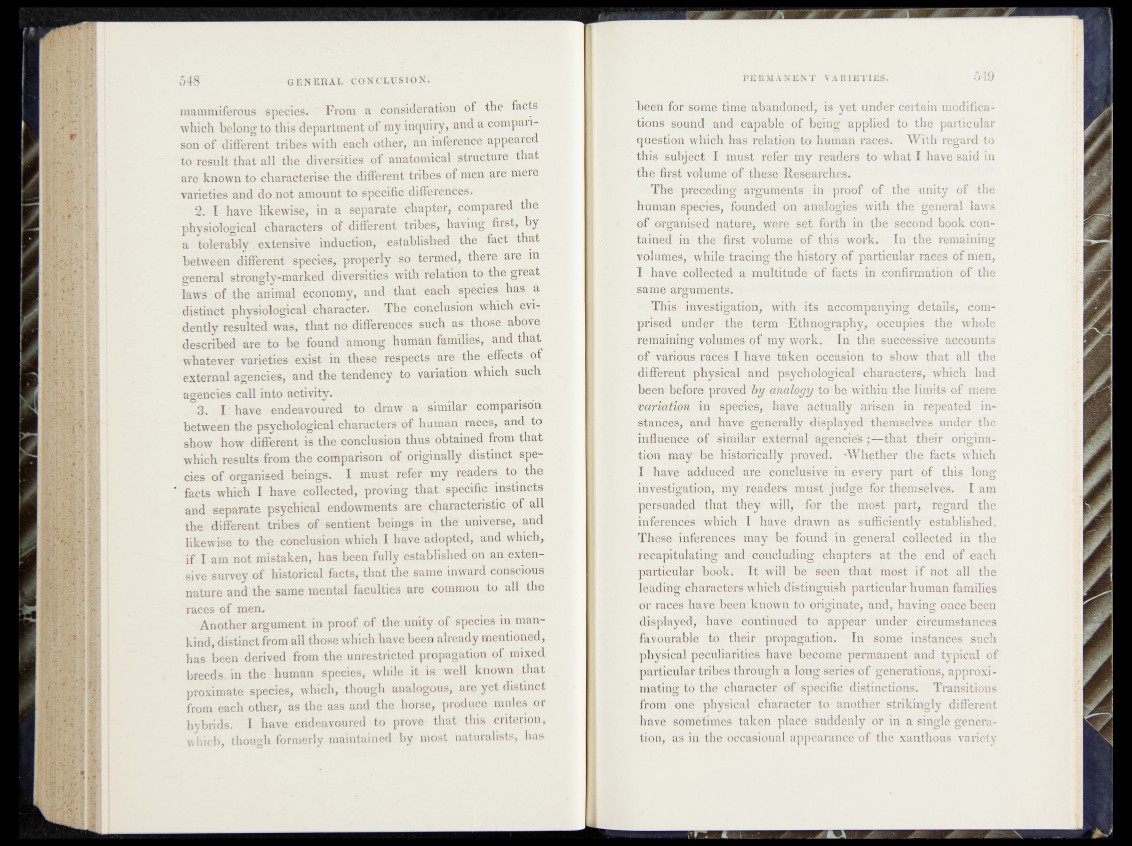
mammiferous species. From a consideration of the facts
which belong to this department of nay inquiry, and a com pari
son of different tribes with each other, an inference appeared
to result that all the diversities of anatomical structure that
are known to characterise the different tribes of men are mere
varieties and do not amount to specific differences.
2. I have likewise, in a separate chapter, compared the
physiological characters of different tribes, having first, by
a tolerably. extensive induction, established the fact that
between different species, properly so termed, there are in
general strongly-marked diversities with relation to the great
laws of the animal economy, and that each "species, has a
distinct physiological character. The conclusion which \|yi-.
dently resulted was, that no differences such as those 'above
described are to be found among human families,, and that
-whatever varieties exist in these respects are. the7effec&£qf
external agencies, and the tendency to variation, which, such
agencies call into activity.
3. I have endeavoured to draw a similar comparison
between the psychological characters of human races,, and , to
show how different is the conclusion thus obtained from th.a£-
which results from the comparison of originally distinct species
of organised beings. I must refer my readers rfo the.
facts which I have collected, proving that specific instincts
and separate psychical endowments are characteristic of all
the different tribes of sentient beings in the universe* and
likewise to the conclusion which I have adopted, and which,
if I am not mistaken, has been fully established on au extensive
survey of historical facts, that the same inward conscious
nature and the same mental faculties are common to all the
faces of men.
Another argument in proof of the unity of species in mankind,
distinct from all those „which have been already mentioned,
has been derived from the unrestricted propagation of. mixed
breeds, in the human species, while it is well known that
proximate species, which, though analogous, are yet distinct
from each other, as the ass and the horse, produce mules or
hybrids. I have endeavoured to prove that this criterion,
which, though formerly maintained by most naturalists, has
been for some time abandoned; is yet under certain modifications
sound and capable of being applied to the particular
question which has 'relation to human races. With regard to
this subject I must refer my readers' to what I have said in
the first' volume of these Researches.
The preceding 'arguments in proof of the unity of the
human spëfeiès, founded on analogies with the general laws
of organised nature, were set forth in the second book contained
in the first volume of this work. In the remaining
volumes, while tracing the history of particular races of men,
I have* collected a multitude of facts in confirmation of the
same' arguments;
- Thi’S' investigation, with its accompanying details, comprised
under the term Ethnography, Occupies the whole
remaining volumes of my work. In the successive accounts
of various races' I have taken occasion to show that all thé
different physical and psychological characters, which had
been before proved by analogy to be within the limits of mere
Variation in species, have actually arisen in repeated instances,
and have generally displayed themselves under the
influence' of similar external agencies ;—that their origina-
tion may be historically-proved. -Whether the facts which
I have adduced"' are conclusive in every part of this long
investigation, my readers must judge' for themselves. I am
persuaded that they will, for the most part, regard the
inferences- -which I have drawn as sufficiently established.
These inferences may be found in_- general collected in the
recapitulating and concluding chapters at the end of each
particular book. It will be seen that most if not all the
leading characters which distinguish particular human families
or races have been known to originate, and, having once been
displayed, have continued to appear under circumstances
favourable to their propagation. In some instances such
physical peculiarities have become permanent and typical of
particular tribes through a long series of generations, approximating
to the character óf specific distinctions. Transitions
from one physical character to another strikingly different
have sometimes taken place suddenly or in a single generation,
as in the occasional appearance of the xanthous variety